Strategic Management Analysis and Recommendations for Cheval Group
VerifiedAdded on 2023/06/10
|20
|3917
|101
Report
AI Summary
This report provides a comprehensive strategic analysis of the Cheval Group of Companies, a UK-based real estate firm, focusing on its potential for international expansion, specifically into Belgium. The analysis begins with a strategic audit, employing PEST and Porter's Five Forces to assess the external environment and the McKinsey 7S framework to evaluate internal resources and capabilities. Competitive strategies are examined through Porter's generic framework and the Ansoff matrix. A SWOT analysis synthesizes the findings, followed by strategic recommendations for the company's expansion into Belgium, considering its favorable political, economic, social, and technological factors. The report also considers the competitive landscape within the real estate industry and the company's internal strengths and weaknesses to provide a well-rounded strategic roadmap for future growth. The report aims to understand the company's current standing in the market and provide recommendations to expand its operations globally.
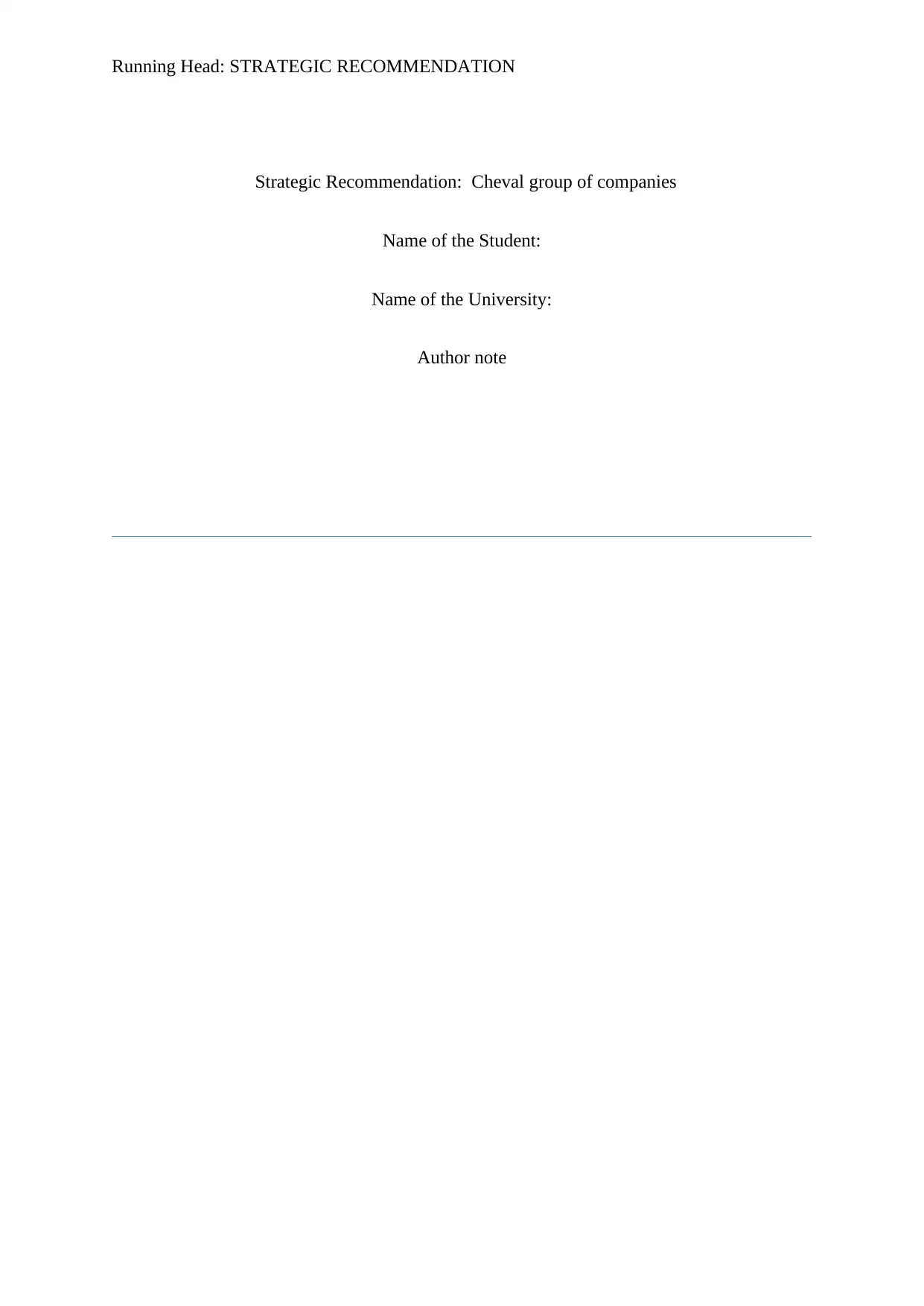
Running Head: STRATEGIC RECOMMENDATION
Strategic Recommendation: Cheval group of companies
Name of the Student:
Name of the University:
Author note
Strategic Recommendation: Cheval group of companies
Name of the Student:
Name of the University:
Author note
Paraphrase This Document
Need a fresh take? Get an instant paraphrase of this document with our AI Paraphraser
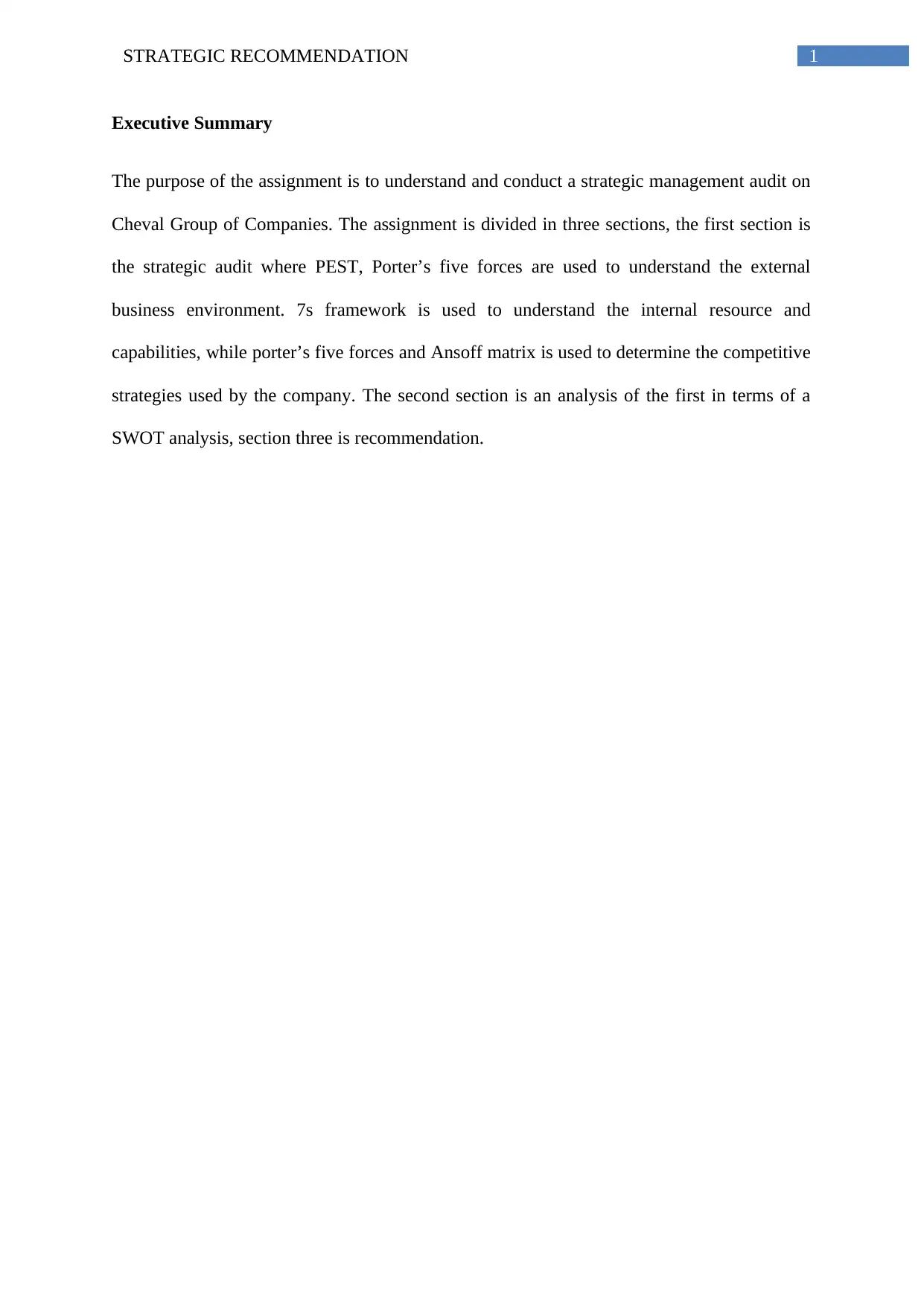
1STRATEGIC RECOMMENDATION
Executive Summary
The purpose of the assignment is to understand and conduct a strategic management audit on
Cheval Group of Companies. The assignment is divided in three sections, the first section is
the strategic audit where PEST, Porter’s five forces are used to understand the external
business environment. 7s framework is used to understand the internal resource and
capabilities, while porter’s five forces and Ansoff matrix is used to determine the competitive
strategies used by the company. The second section is an analysis of the first in terms of a
SWOT analysis, section three is recommendation.
Executive Summary
The purpose of the assignment is to understand and conduct a strategic management audit on
Cheval Group of Companies. The assignment is divided in three sections, the first section is
the strategic audit where PEST, Porter’s five forces are used to understand the external
business environment. 7s framework is used to understand the internal resource and
capabilities, while porter’s five forces and Ansoff matrix is used to determine the competitive
strategies used by the company. The second section is an analysis of the first in terms of a
SWOT analysis, section three is recommendation.
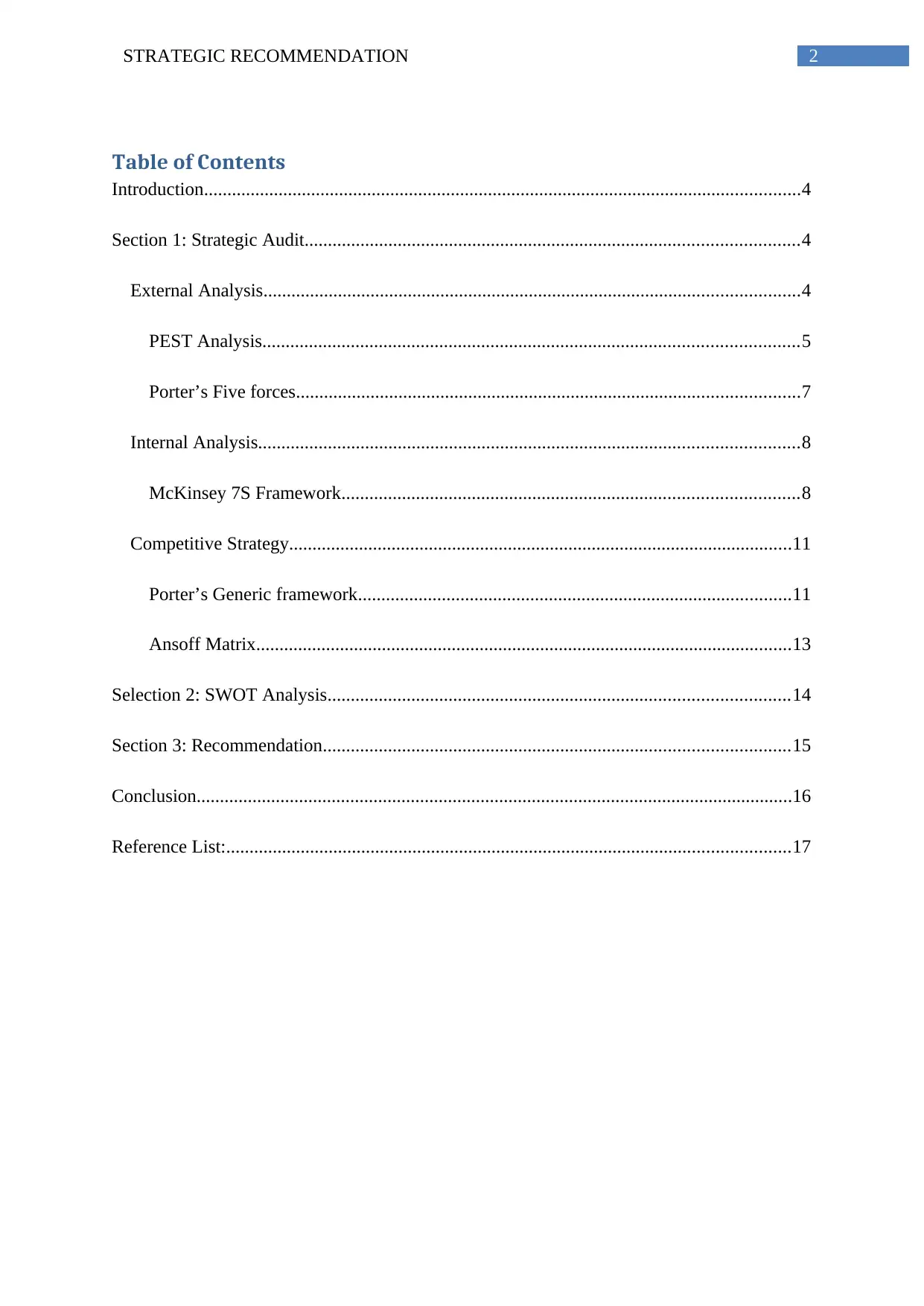
2STRATEGIC RECOMMENDATION
Table of Contents
Introduction................................................................................................................................4
Section 1: Strategic Audit..........................................................................................................4
External Analysis...................................................................................................................4
PEST Analysis...................................................................................................................5
Porter’s Five forces............................................................................................................7
Internal Analysis....................................................................................................................8
McKinsey 7S Framework..................................................................................................8
Competitive Strategy............................................................................................................11
Porter’s Generic framework.............................................................................................11
Ansoff Matrix...................................................................................................................13
Selection 2: SWOT Analysis...................................................................................................14
Section 3: Recommendation....................................................................................................15
Conclusion................................................................................................................................16
Reference List:.........................................................................................................................17
Table of Contents
Introduction................................................................................................................................4
Section 1: Strategic Audit..........................................................................................................4
External Analysis...................................................................................................................4
PEST Analysis...................................................................................................................5
Porter’s Five forces............................................................................................................7
Internal Analysis....................................................................................................................8
McKinsey 7S Framework..................................................................................................8
Competitive Strategy............................................................................................................11
Porter’s Generic framework.............................................................................................11
Ansoff Matrix...................................................................................................................13
Selection 2: SWOT Analysis...................................................................................................14
Section 3: Recommendation....................................................................................................15
Conclusion................................................................................................................................16
Reference List:.........................................................................................................................17
⊘ This is a preview!⊘
Do you want full access?
Subscribe today to unlock all pages.

Trusted by 1+ million students worldwide
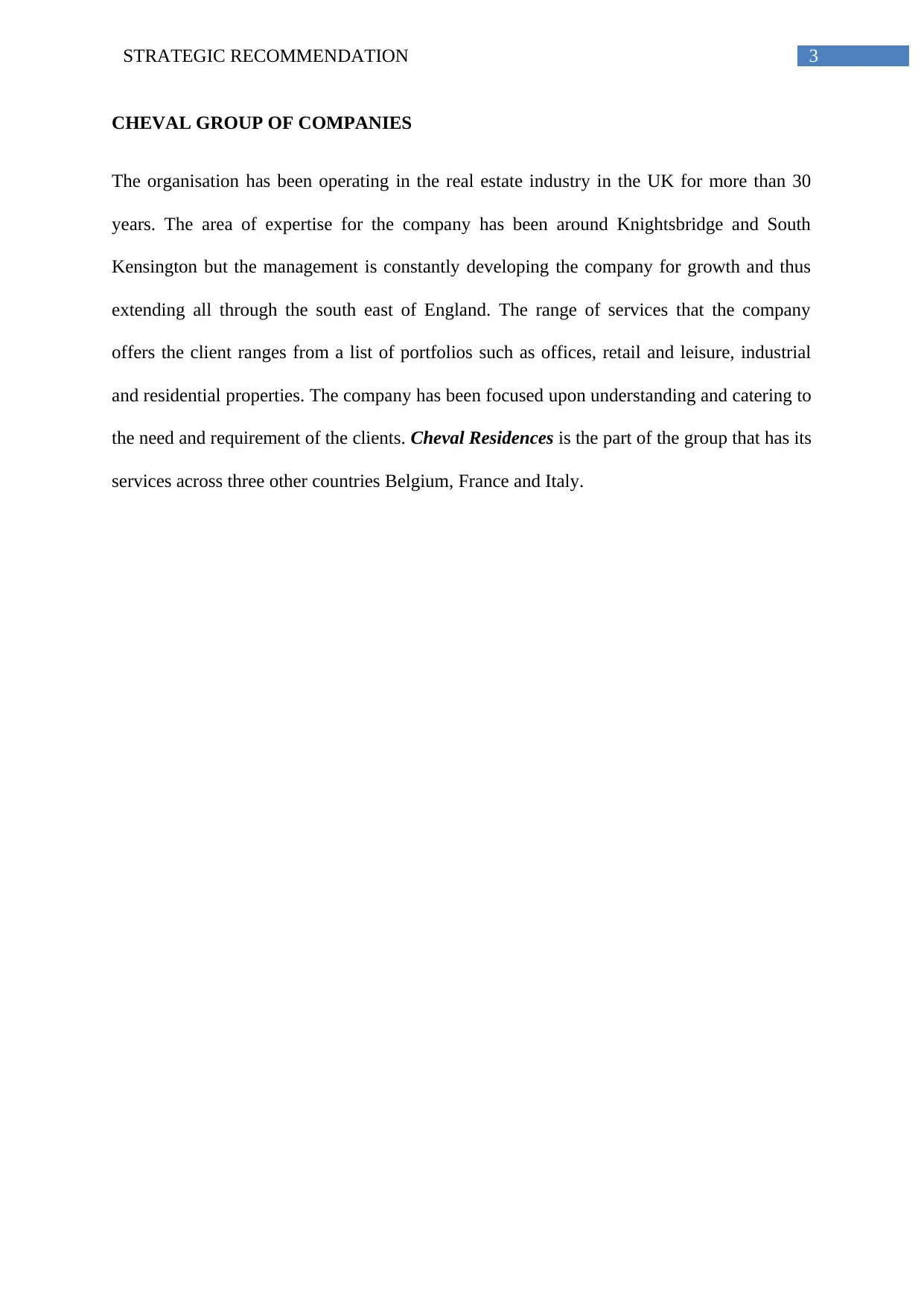
3STRATEGIC RECOMMENDATION
CHEVAL GROUP OF COMPANIES
The organisation has been operating in the real estate industry in the UK for more than 30
years. The area of expertise for the company has been around Knightsbridge and South
Kensington but the management is constantly developing the company for growth and thus
extending all through the south east of England. The range of services that the company
offers the client ranges from a list of portfolios such as offices, retail and leisure, industrial
and residential properties. The company has been focused upon understanding and catering to
the need and requirement of the clients. Cheval Residences is the part of the group that has its
services across three other countries Belgium, France and Italy.
CHEVAL GROUP OF COMPANIES
The organisation has been operating in the real estate industry in the UK for more than 30
years. The area of expertise for the company has been around Knightsbridge and South
Kensington but the management is constantly developing the company for growth and thus
extending all through the south east of England. The range of services that the company
offers the client ranges from a list of portfolios such as offices, retail and leisure, industrial
and residential properties. The company has been focused upon understanding and catering to
the need and requirement of the clients. Cheval Residences is the part of the group that has its
services across three other countries Belgium, France and Italy.
Paraphrase This Document
Need a fresh take? Get an instant paraphrase of this document with our AI Paraphraser
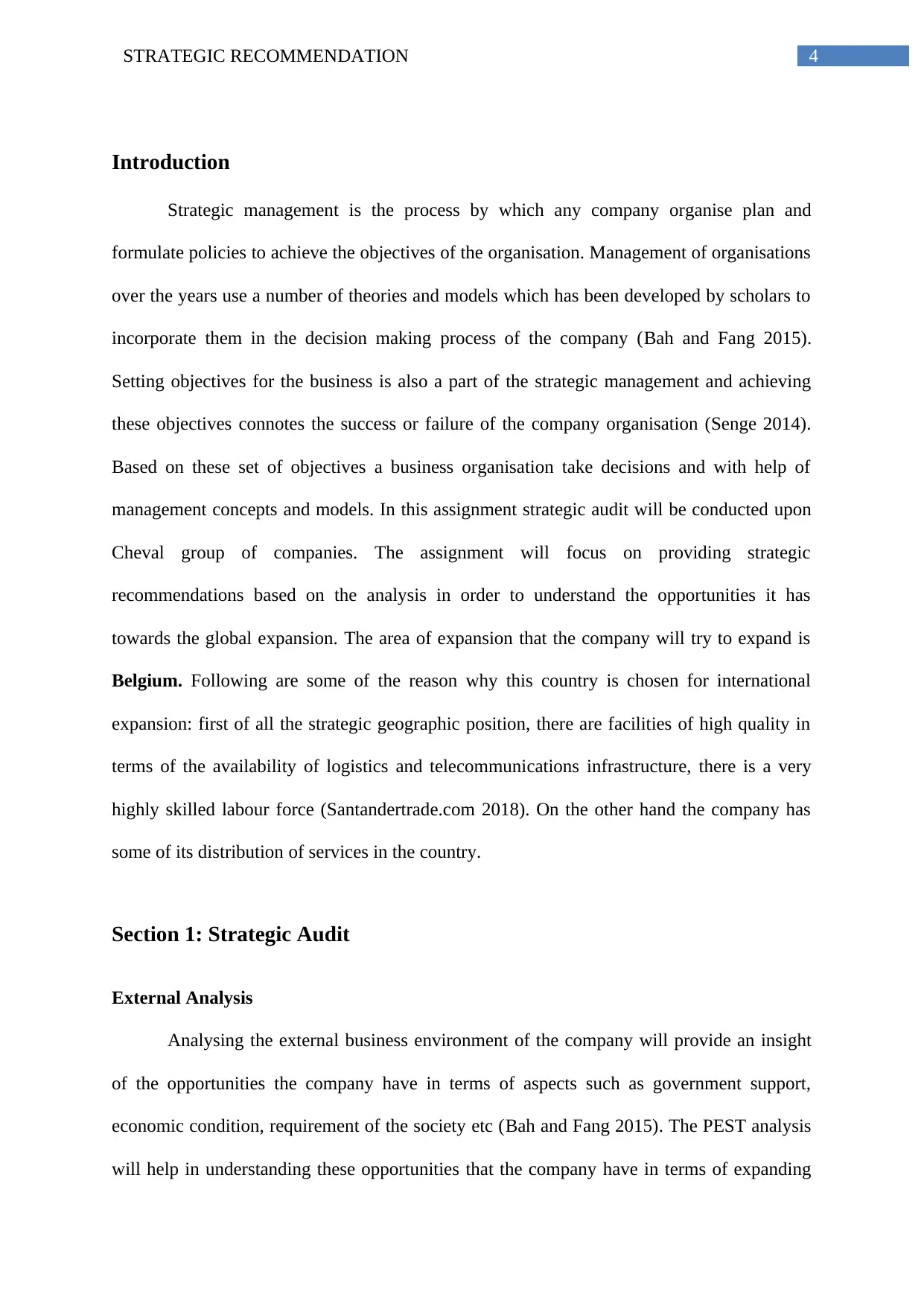
4STRATEGIC RECOMMENDATION
Introduction
Strategic management is the process by which any company organise plan and
formulate policies to achieve the objectives of the organisation. Management of organisations
over the years use a number of theories and models which has been developed by scholars to
incorporate them in the decision making process of the company (Bah and Fang 2015).
Setting objectives for the business is also a part of the strategic management and achieving
these objectives connotes the success or failure of the company organisation (Senge 2014).
Based on these set of objectives a business organisation take decisions and with help of
management concepts and models. In this assignment strategic audit will be conducted upon
Cheval group of companies. The assignment will focus on providing strategic
recommendations based on the analysis in order to understand the opportunities it has
towards the global expansion. The area of expansion that the company will try to expand is
Belgium. Following are some of the reason why this country is chosen for international
expansion: first of all the strategic geographic position, there are facilities of high quality in
terms of the availability of logistics and telecommunications infrastructure, there is a very
highly skilled labour force (Santandertrade.com 2018). On the other hand the company has
some of its distribution of services in the country.
Section 1: Strategic Audit
External Analysis
Analysing the external business environment of the company will provide an insight
of the opportunities the company have in terms of aspects such as government support,
economic condition, requirement of the society etc (Bah and Fang 2015). The PEST analysis
will help in understanding these opportunities that the company have in terms of expanding
Introduction
Strategic management is the process by which any company organise plan and
formulate policies to achieve the objectives of the organisation. Management of organisations
over the years use a number of theories and models which has been developed by scholars to
incorporate them in the decision making process of the company (Bah and Fang 2015).
Setting objectives for the business is also a part of the strategic management and achieving
these objectives connotes the success or failure of the company organisation (Senge 2014).
Based on these set of objectives a business organisation take decisions and with help of
management concepts and models. In this assignment strategic audit will be conducted upon
Cheval group of companies. The assignment will focus on providing strategic
recommendations based on the analysis in order to understand the opportunities it has
towards the global expansion. The area of expansion that the company will try to expand is
Belgium. Following are some of the reason why this country is chosen for international
expansion: first of all the strategic geographic position, there are facilities of high quality in
terms of the availability of logistics and telecommunications infrastructure, there is a very
highly skilled labour force (Santandertrade.com 2018). On the other hand the company has
some of its distribution of services in the country.
Section 1: Strategic Audit
External Analysis
Analysing the external business environment of the company will provide an insight
of the opportunities the company have in terms of aspects such as government support,
economic condition, requirement of the society etc (Bah and Fang 2015). The PEST analysis
will help in understanding these opportunities that the company have in terms of expanding
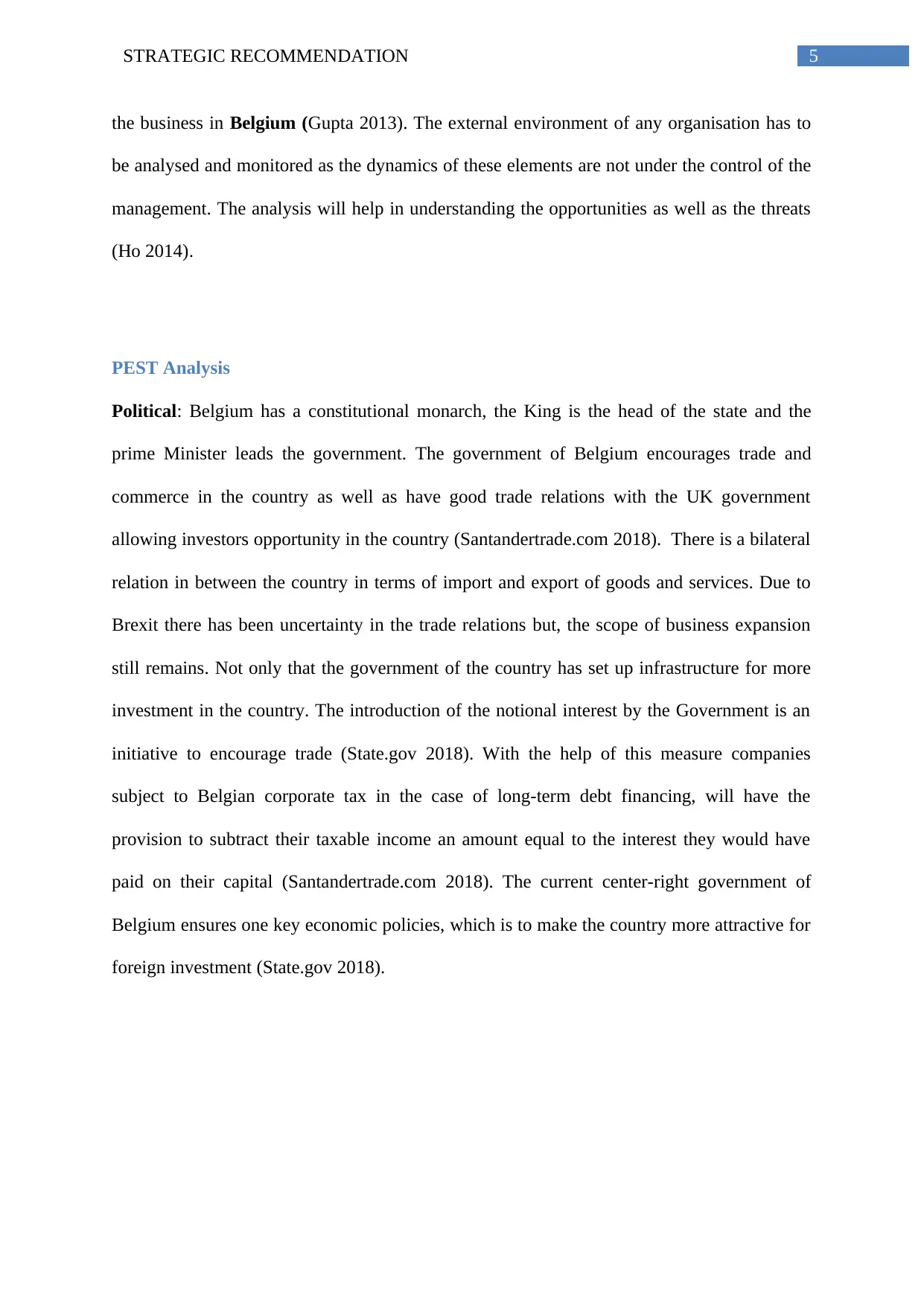
5STRATEGIC RECOMMENDATION
the business in Belgium (Gupta 2013). The external environment of any organisation has to
be analysed and monitored as the dynamics of these elements are not under the control of the
management. The analysis will help in understanding the opportunities as well as the threats
(Ho 2014).
PEST Analysis
Political: Belgium has a constitutional monarch, the King is the head of the state and the
prime Minister leads the government. The government of Belgium encourages trade and
commerce in the country as well as have good trade relations with the UK government
allowing investors opportunity in the country (Santandertrade.com 2018). There is a bilateral
relation in between the country in terms of import and export of goods and services. Due to
Brexit there has been uncertainty in the trade relations but, the scope of business expansion
still remains. Not only that the government of the country has set up infrastructure for more
investment in the country. The introduction of the notional interest by the Government is an
initiative to encourage trade (State.gov 2018). With the help of this measure companies
subject to Belgian corporate tax in the case of long-term debt financing, will have the
provision to subtract their taxable income an amount equal to the interest they would have
paid on their capital (Santandertrade.com 2018). The current center-right government of
Belgium ensures one key economic policies, which is to make the country more attractive for
foreign investment (State.gov 2018).
the business in Belgium (Gupta 2013). The external environment of any organisation has to
be analysed and monitored as the dynamics of these elements are not under the control of the
management. The analysis will help in understanding the opportunities as well as the threats
(Ho 2014).
PEST Analysis
Political: Belgium has a constitutional monarch, the King is the head of the state and the
prime Minister leads the government. The government of Belgium encourages trade and
commerce in the country as well as have good trade relations with the UK government
allowing investors opportunity in the country (Santandertrade.com 2018). There is a bilateral
relation in between the country in terms of import and export of goods and services. Due to
Brexit there has been uncertainty in the trade relations but, the scope of business expansion
still remains. Not only that the government of the country has set up infrastructure for more
investment in the country. The introduction of the notional interest by the Government is an
initiative to encourage trade (State.gov 2018). With the help of this measure companies
subject to Belgian corporate tax in the case of long-term debt financing, will have the
provision to subtract their taxable income an amount equal to the interest they would have
paid on their capital (Santandertrade.com 2018). The current center-right government of
Belgium ensures one key economic policies, which is to make the country more attractive for
foreign investment (State.gov 2018).
⊘ This is a preview!⊘
Do you want full access?
Subscribe today to unlock all pages.

Trusted by 1+ million students worldwide
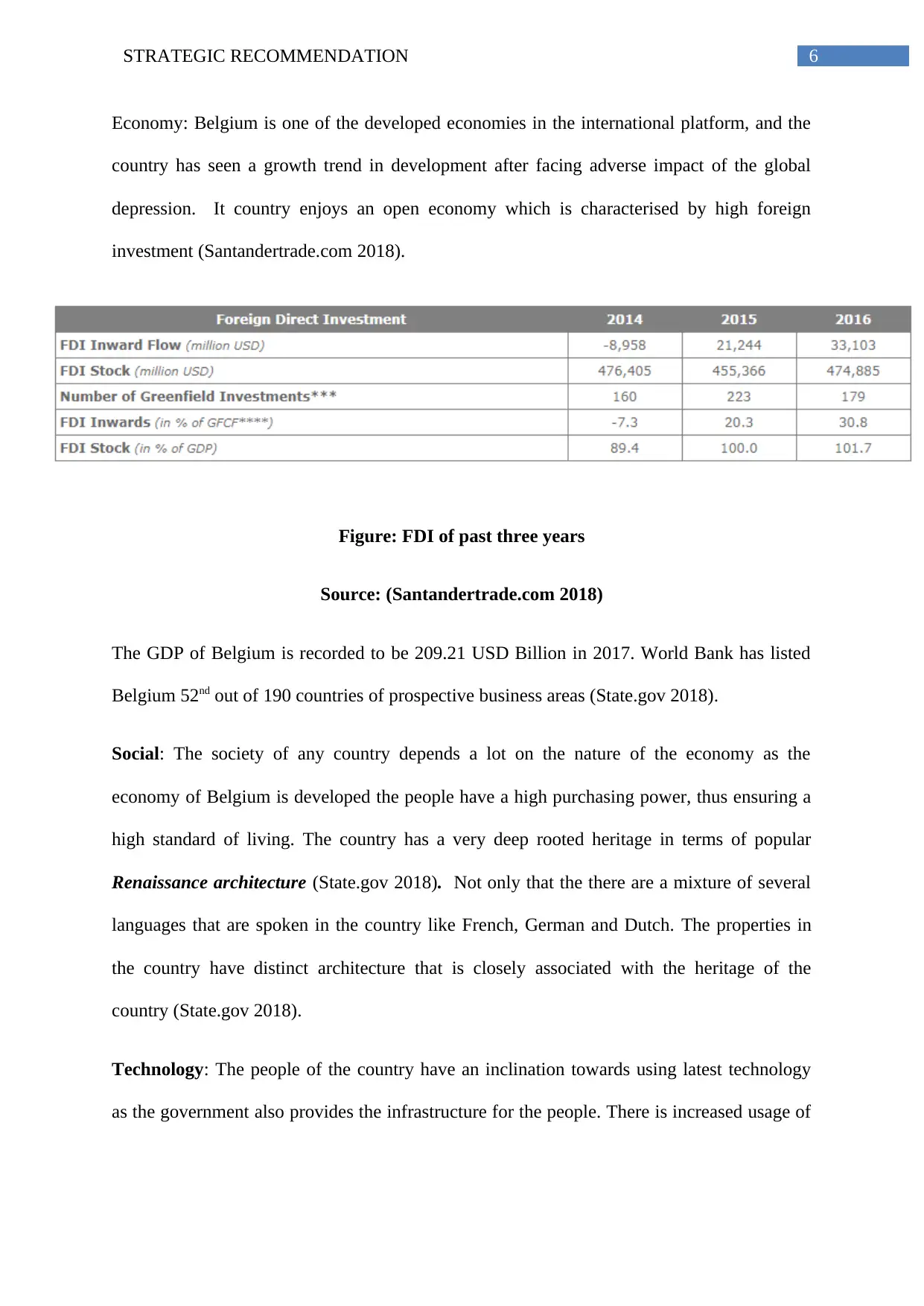
6STRATEGIC RECOMMENDATION
Economy: Belgium is one of the developed economies in the international platform, and the
country has seen a growth trend in development after facing adverse impact of the global
depression. It country enjoys an open economy which is characterised by high foreign
investment (Santandertrade.com 2018).
Figure: FDI of past three years
Source: (Santandertrade.com 2018)
The GDP of Belgium is recorded to be 209.21 USD Billion in 2017. World Bank has listed
Belgium 52nd out of 190 countries of prospective business areas (State.gov 2018).
Social: The society of any country depends a lot on the nature of the economy as the
economy of Belgium is developed the people have a high purchasing power, thus ensuring a
high standard of living. The country has a very deep rooted heritage in terms of popular
Renaissance architecture (State.gov 2018). Not only that the there are a mixture of several
languages that are spoken in the country like French, German and Dutch. The properties in
the country have distinct architecture that is closely associated with the heritage of the
country (State.gov 2018).
Technology: The people of the country have an inclination towards using latest technology
as the government also provides the infrastructure for the people. There is increased usage of
Economy: Belgium is one of the developed economies in the international platform, and the
country has seen a growth trend in development after facing adverse impact of the global
depression. It country enjoys an open economy which is characterised by high foreign
investment (Santandertrade.com 2018).
Figure: FDI of past three years
Source: (Santandertrade.com 2018)
The GDP of Belgium is recorded to be 209.21 USD Billion in 2017. World Bank has listed
Belgium 52nd out of 190 countries of prospective business areas (State.gov 2018).
Social: The society of any country depends a lot on the nature of the economy as the
economy of Belgium is developed the people have a high purchasing power, thus ensuring a
high standard of living. The country has a very deep rooted heritage in terms of popular
Renaissance architecture (State.gov 2018). Not only that the there are a mixture of several
languages that are spoken in the country like French, German and Dutch. The properties in
the country have distinct architecture that is closely associated with the heritage of the
country (State.gov 2018).
Technology: The people of the country have an inclination towards using latest technology
as the government also provides the infrastructure for the people. There is increased usage of
Paraphrase This Document
Need a fresh take? Get an instant paraphrase of this document with our AI Paraphraser
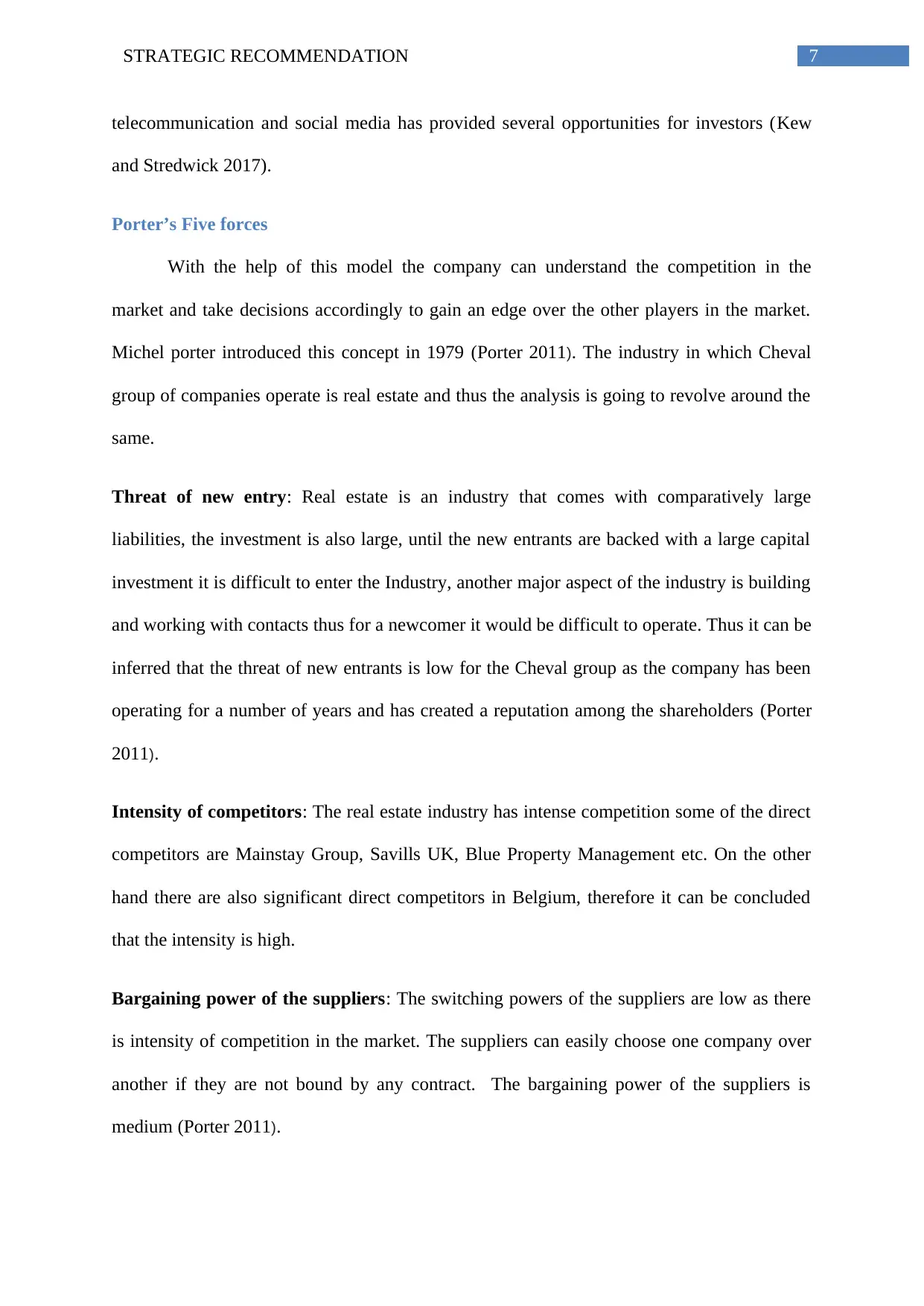
7STRATEGIC RECOMMENDATION
telecommunication and social media has provided several opportunities for investors (Kew
and Stredwick 2017).
Porter’s Five forces
With the help of this model the company can understand the competition in the
market and take decisions accordingly to gain an edge over the other players in the market.
Michel porter introduced this concept in 1979 (Porter 2011). The industry in which Cheval
group of companies operate is real estate and thus the analysis is going to revolve around the
same.
Threat of new entry: Real estate is an industry that comes with comparatively large
liabilities, the investment is also large, until the new entrants are backed with a large capital
investment it is difficult to enter the Industry, another major aspect of the industry is building
and working with contacts thus for a newcomer it would be difficult to operate. Thus it can be
inferred that the threat of new entrants is low for the Cheval group as the company has been
operating for a number of years and has created a reputation among the shareholders (Porter
2011).
Intensity of competitors: The real estate industry has intense competition some of the direct
competitors are Mainstay Group, Savills UK, Blue Property Management etc. On the other
hand there are also significant direct competitors in Belgium, therefore it can be concluded
that the intensity is high.
Bargaining power of the suppliers: The switching powers of the suppliers are low as there
is intensity of competition in the market. The suppliers can easily choose one company over
another if they are not bound by any contract. The bargaining power of the suppliers is
medium (Porter 2011).
telecommunication and social media has provided several opportunities for investors (Kew
and Stredwick 2017).
Porter’s Five forces
With the help of this model the company can understand the competition in the
market and take decisions accordingly to gain an edge over the other players in the market.
Michel porter introduced this concept in 1979 (Porter 2011). The industry in which Cheval
group of companies operate is real estate and thus the analysis is going to revolve around the
same.
Threat of new entry: Real estate is an industry that comes with comparatively large
liabilities, the investment is also large, until the new entrants are backed with a large capital
investment it is difficult to enter the Industry, another major aspect of the industry is building
and working with contacts thus for a newcomer it would be difficult to operate. Thus it can be
inferred that the threat of new entrants is low for the Cheval group as the company has been
operating for a number of years and has created a reputation among the shareholders (Porter
2011).
Intensity of competitors: The real estate industry has intense competition some of the direct
competitors are Mainstay Group, Savills UK, Blue Property Management etc. On the other
hand there are also significant direct competitors in Belgium, therefore it can be concluded
that the intensity is high.
Bargaining power of the suppliers: The switching powers of the suppliers are low as there
is intensity of competition in the market. The suppliers can easily choose one company over
another if they are not bound by any contract. The bargaining power of the suppliers is
medium (Porter 2011).
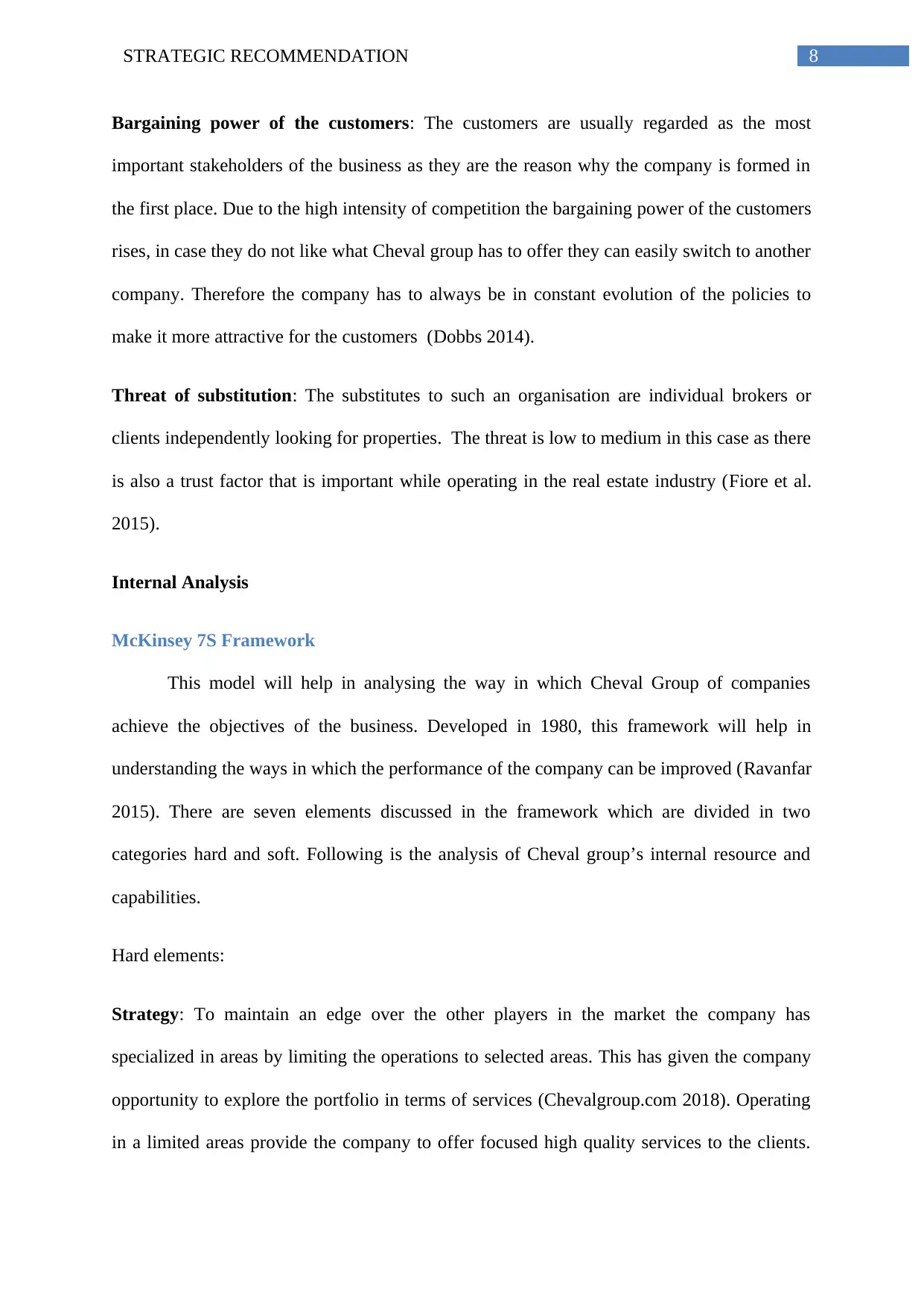
8STRATEGIC RECOMMENDATION
Bargaining power of the customers: The customers are usually regarded as the most
important stakeholders of the business as they are the reason why the company is formed in
the first place. Due to the high intensity of competition the bargaining power of the customers
rises, in case they do not like what Cheval group has to offer they can easily switch to another
company. Therefore the company has to always be in constant evolution of the policies to
make it more attractive for the customers (Dobbs 2014).
Threat of substitution: The substitutes to such an organisation are individual brokers or
clients independently looking for properties. The threat is low to medium in this case as there
is also a trust factor that is important while operating in the real estate industry (Fiore et al.
2015).
Internal Analysis
McKinsey 7S Framework
This model will help in analysing the way in which Cheval Group of companies
achieve the objectives of the business. Developed in 1980, this framework will help in
understanding the ways in which the performance of the company can be improved (Ravanfar
2015). There are seven elements discussed in the framework which are divided in two
categories hard and soft. Following is the analysis of Cheval group’s internal resource and
capabilities.
Hard elements:
Strategy: To maintain an edge over the other players in the market the company has
specialized in areas by limiting the operations to selected areas. This has given the company
opportunity to explore the portfolio in terms of services (Chevalgroup.com 2018). Operating
in a limited areas provide the company to offer focused high quality services to the clients.
Bargaining power of the customers: The customers are usually regarded as the most
important stakeholders of the business as they are the reason why the company is formed in
the first place. Due to the high intensity of competition the bargaining power of the customers
rises, in case they do not like what Cheval group has to offer they can easily switch to another
company. Therefore the company has to always be in constant evolution of the policies to
make it more attractive for the customers (Dobbs 2014).
Threat of substitution: The substitutes to such an organisation are individual brokers or
clients independently looking for properties. The threat is low to medium in this case as there
is also a trust factor that is important while operating in the real estate industry (Fiore et al.
2015).
Internal Analysis
McKinsey 7S Framework
This model will help in analysing the way in which Cheval Group of companies
achieve the objectives of the business. Developed in 1980, this framework will help in
understanding the ways in which the performance of the company can be improved (Ravanfar
2015). There are seven elements discussed in the framework which are divided in two
categories hard and soft. Following is the analysis of Cheval group’s internal resource and
capabilities.
Hard elements:
Strategy: To maintain an edge over the other players in the market the company has
specialized in areas by limiting the operations to selected areas. This has given the company
opportunity to explore the portfolio in terms of services (Chevalgroup.com 2018). Operating
in a limited areas provide the company to offer focused high quality services to the clients.
⊘ This is a preview!⊘
Do you want full access?
Subscribe today to unlock all pages.

Trusted by 1+ million students worldwide
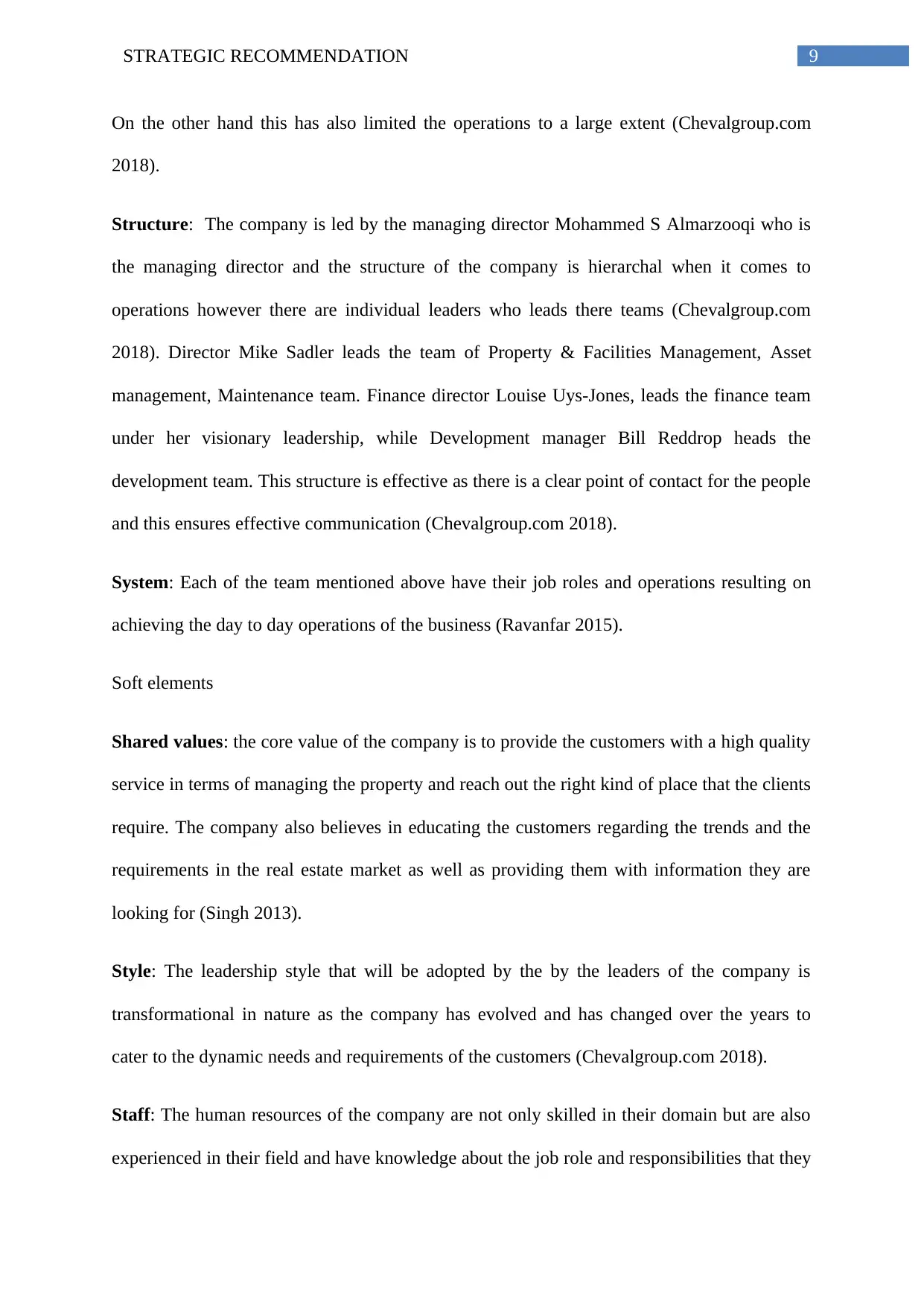
9STRATEGIC RECOMMENDATION
On the other hand this has also limited the operations to a large extent (Chevalgroup.com
2018).
Structure: The company is led by the managing director Mohammed S Almarzooqi who is
the managing director and the structure of the company is hierarchal when it comes to
operations however there are individual leaders who leads there teams (Chevalgroup.com
2018). Director Mike Sadler leads the team of Property & Facilities Management, Asset
management, Maintenance team. Finance director Louise Uys-Jones, leads the finance team
under her visionary leadership, while Development manager Bill Reddrop heads the
development team. This structure is effective as there is a clear point of contact for the people
and this ensures effective communication (Chevalgroup.com 2018).
System: Each of the team mentioned above have their job roles and operations resulting on
achieving the day to day operations of the business (Ravanfar 2015).
Soft elements
Shared values: the core value of the company is to provide the customers with a high quality
service in terms of managing the property and reach out the right kind of place that the clients
require. The company also believes in educating the customers regarding the trends and the
requirements in the real estate market as well as providing them with information they are
looking for (Singh 2013).
Style: The leadership style that will be adopted by the by the leaders of the company is
transformational in nature as the company has evolved and has changed over the years to
cater to the dynamic needs and requirements of the customers (Chevalgroup.com 2018).
Staff: The human resources of the company are not only skilled in their domain but are also
experienced in their field and have knowledge about the job role and responsibilities that they
On the other hand this has also limited the operations to a large extent (Chevalgroup.com
2018).
Structure: The company is led by the managing director Mohammed S Almarzooqi who is
the managing director and the structure of the company is hierarchal when it comes to
operations however there are individual leaders who leads there teams (Chevalgroup.com
2018). Director Mike Sadler leads the team of Property & Facilities Management, Asset
management, Maintenance team. Finance director Louise Uys-Jones, leads the finance team
under her visionary leadership, while Development manager Bill Reddrop heads the
development team. This structure is effective as there is a clear point of contact for the people
and this ensures effective communication (Chevalgroup.com 2018).
System: Each of the team mentioned above have their job roles and operations resulting on
achieving the day to day operations of the business (Ravanfar 2015).
Soft elements
Shared values: the core value of the company is to provide the customers with a high quality
service in terms of managing the property and reach out the right kind of place that the clients
require. The company also believes in educating the customers regarding the trends and the
requirements in the real estate market as well as providing them with information they are
looking for (Singh 2013).
Style: The leadership style that will be adopted by the by the leaders of the company is
transformational in nature as the company has evolved and has changed over the years to
cater to the dynamic needs and requirements of the customers (Chevalgroup.com 2018).
Staff: The human resources of the company are not only skilled in their domain but are also
experienced in their field and have knowledge about the job role and responsibilities that they
Paraphrase This Document
Need a fresh take? Get an instant paraphrase of this document with our AI Paraphraser
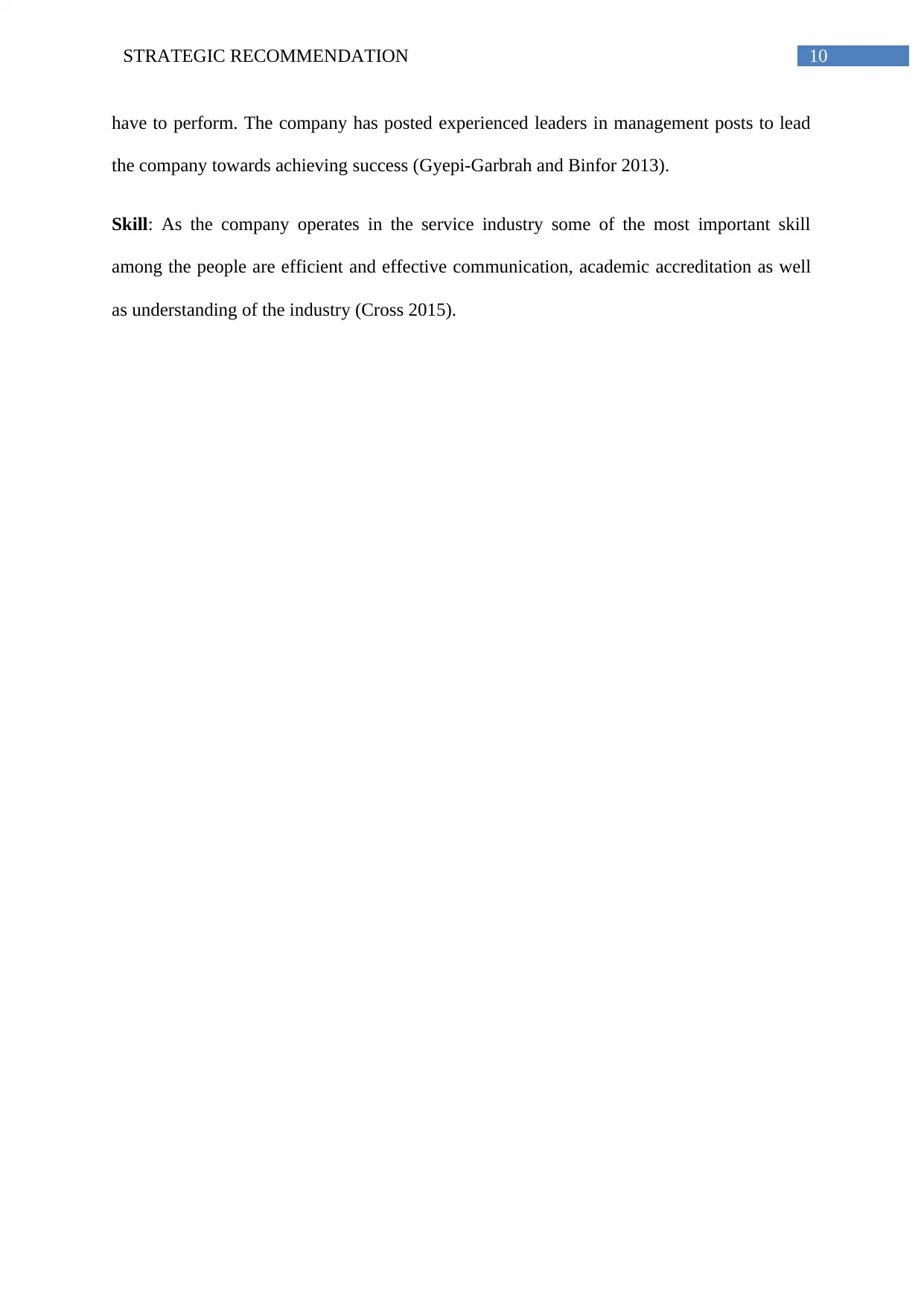
10STRATEGIC RECOMMENDATION
have to perform. The company has posted experienced leaders in management posts to lead
the company towards achieving success (Gyepi-Garbrah and Binfor 2013).
Skill: As the company operates in the service industry some of the most important skill
among the people are efficient and effective communication, academic accreditation as well
as understanding of the industry (Cross 2015).
have to perform. The company has posted experienced leaders in management posts to lead
the company towards achieving success (Gyepi-Garbrah and Binfor 2013).
Skill: As the company operates in the service industry some of the most important skill
among the people are efficient and effective communication, academic accreditation as well
as understanding of the industry (Cross 2015).
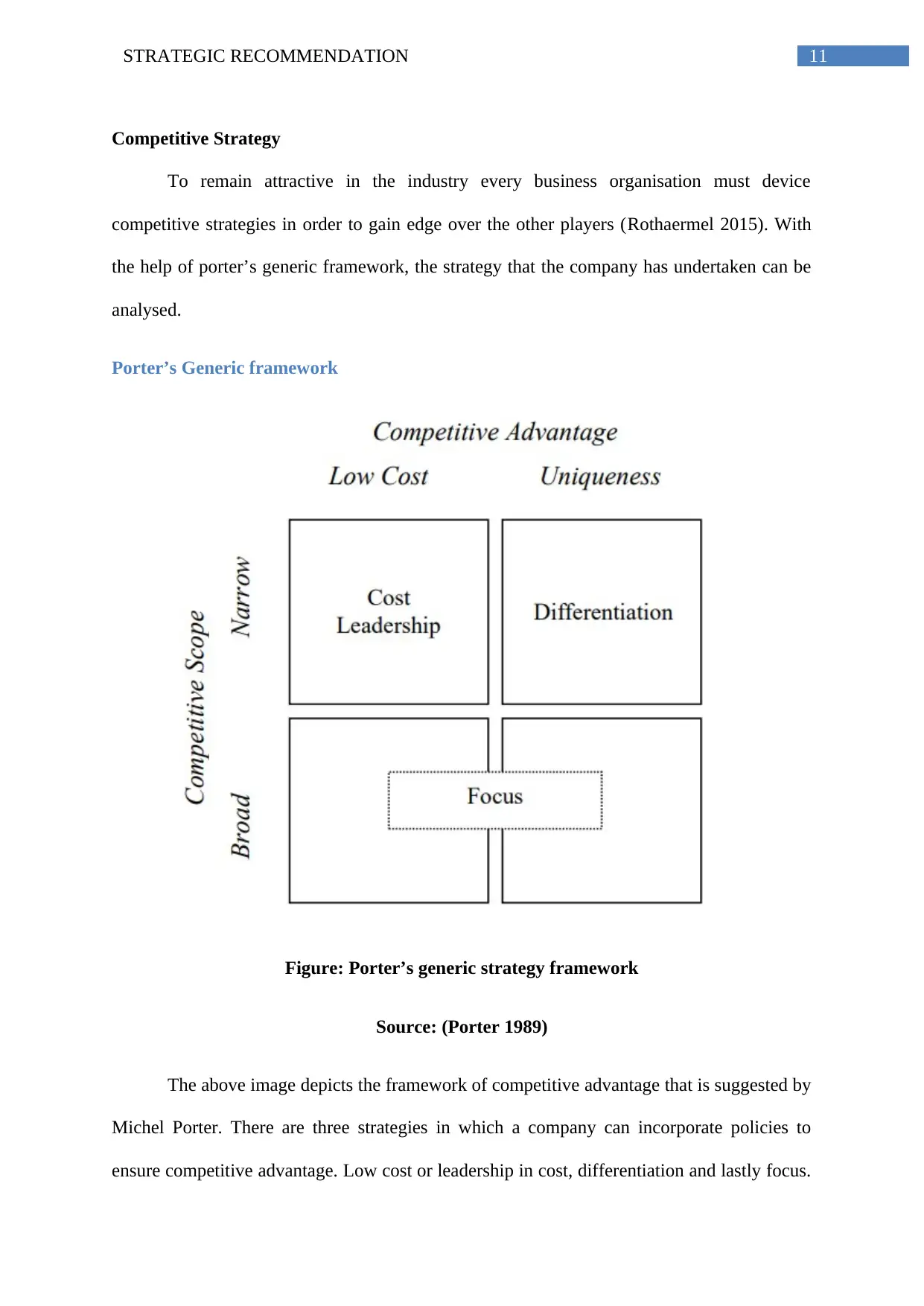
11STRATEGIC RECOMMENDATION
Competitive Strategy
To remain attractive in the industry every business organisation must device
competitive strategies in order to gain edge over the other players (Rothaermel 2015). With
the help of porter’s generic framework, the strategy that the company has undertaken can be
analysed.
Porter’s Generic framework
Figure: Porter’s generic strategy framework
Source: (Porter 1989)
The above image depicts the framework of competitive advantage that is suggested by
Michel Porter. There are three strategies in which a company can incorporate policies to
ensure competitive advantage. Low cost or leadership in cost, differentiation and lastly focus.
Competitive Strategy
To remain attractive in the industry every business organisation must device
competitive strategies in order to gain edge over the other players (Rothaermel 2015). With
the help of porter’s generic framework, the strategy that the company has undertaken can be
analysed.
Porter’s Generic framework
Figure: Porter’s generic strategy framework
Source: (Porter 1989)
The above image depicts the framework of competitive advantage that is suggested by
Michel Porter. There are three strategies in which a company can incorporate policies to
ensure competitive advantage. Low cost or leadership in cost, differentiation and lastly focus.
⊘ This is a preview!⊘
Do you want full access?
Subscribe today to unlock all pages.

Trusted by 1+ million students worldwide
1 out of 20
Related Documents
Your All-in-One AI-Powered Toolkit for Academic Success.
+13062052269
info@desklib.com
Available 24*7 on WhatsApp / Email
![[object Object]](/_next/static/media/star-bottom.7253800d.svg)
Unlock your academic potential
Copyright © 2020–2025 A2Z Services. All Rights Reserved. Developed and managed by ZUCOL.





